Human Resource Management Report: College HRM Practices Analysis
VerifiedAdded on 2020/01/28
|18
|5550
|198
Report
AI Summary
This report provides a comprehensive analysis of Human Resource Management (HRM) practices, specifically focusing on recruitment, selection, and employee performance within the context of Woodhill College. The report begins by examining the importance of HRM in the current business environment, highlighting the shift from viewing HR as a cost center to recognizing its value as a key asset. Part 1 delves into recruitment and selection, including HR planning, the role of the HR manager, and different recruitment approaches (personalized vs. systematic). The report also covers key functional areas of HRM, such as recruitment, training and development, compensation, and legal compliance. Part 2 addresses employee performance, development, and reward systems, while Part 3 explores employment relationships. The report provides a detailed job advertisement and job/person specifications for a lecturer position, along with a discussion of advertising platforms. It also explores the impact of various HRM practices, emphasizing the importance of aligning these practices with organizational goals and objectives. The report concludes with an overview of the potential benefits and drawbacks of different recruitment methods and HRM practices.
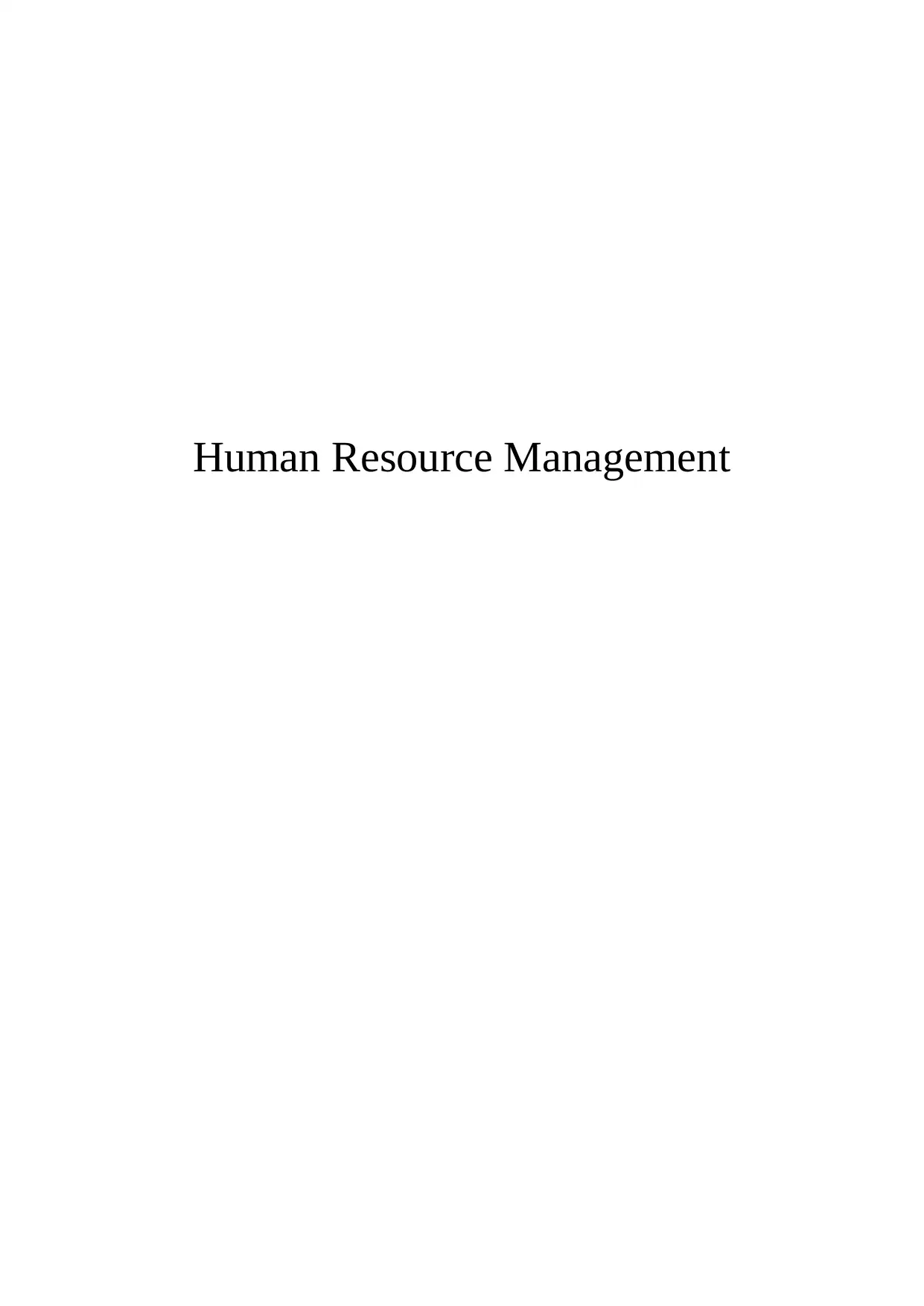
Human Resource Management
Paraphrase This Document
Need a fresh take? Get an instant paraphrase of this document with our AI Paraphraser
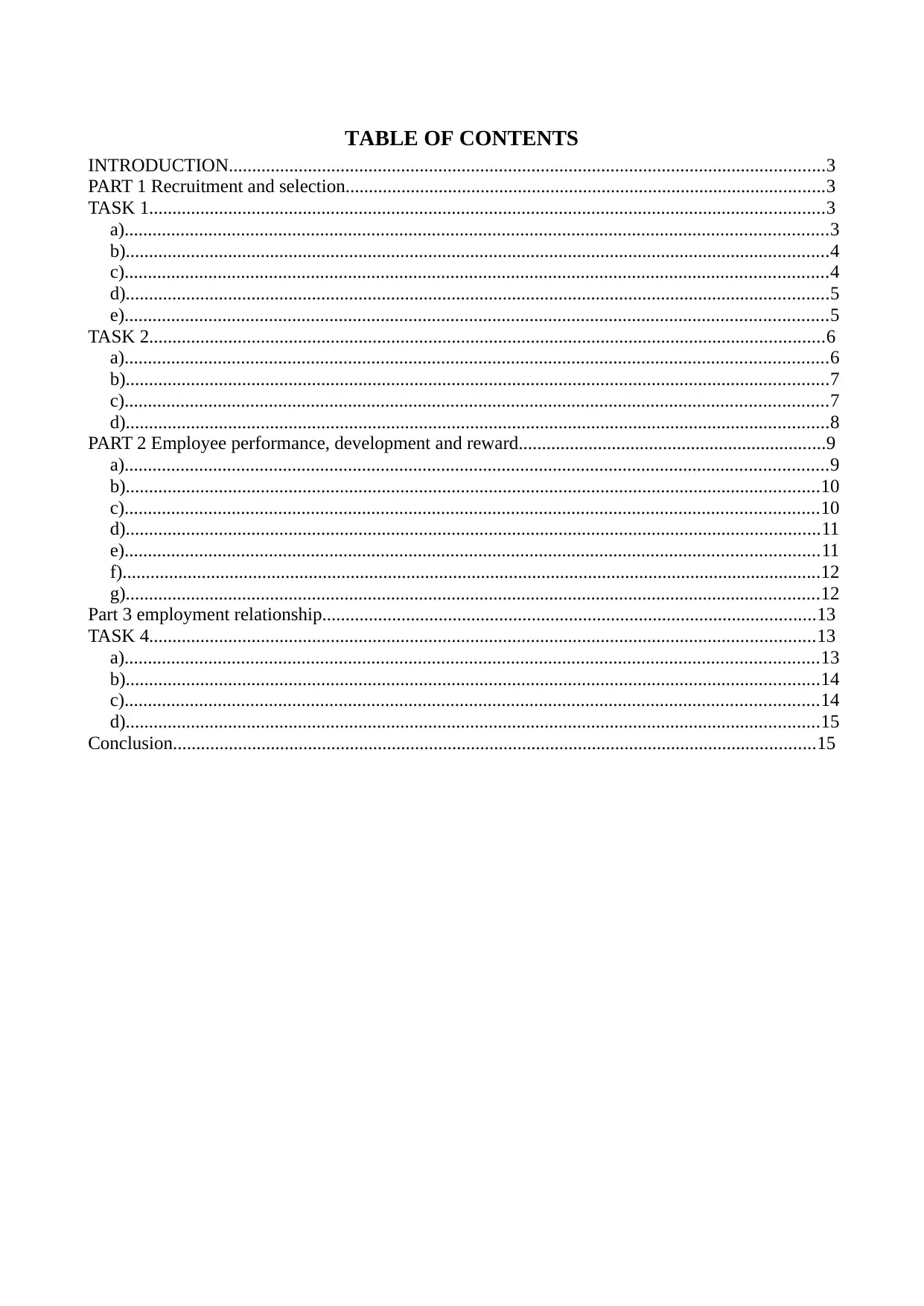
TABLE OF CONTENTS
INTRODUCTION................................................................................................................................3
PART 1 Recruitment and selection.......................................................................................................3
TASK 1.................................................................................................................................................3
a).......................................................................................................................................................3
b).......................................................................................................................................................4
c).......................................................................................................................................................4
d).......................................................................................................................................................5
e).......................................................................................................................................................5
TASK 2.................................................................................................................................................6
a).......................................................................................................................................................6
b).......................................................................................................................................................7
c).......................................................................................................................................................7
d).......................................................................................................................................................8
PART 2 Employee performance, development and reward..................................................................9
a).......................................................................................................................................................9
b).....................................................................................................................................................10
c).....................................................................................................................................................10
d).....................................................................................................................................................11
e).....................................................................................................................................................11
f)......................................................................................................................................................12
g).....................................................................................................................................................12
Part 3 employment relationship..........................................................................................................13
TASK 4...............................................................................................................................................13
a).....................................................................................................................................................13
b).....................................................................................................................................................14
c).....................................................................................................................................................14
d).....................................................................................................................................................15
Conclusion..........................................................................................................................................15
INTRODUCTION................................................................................................................................3
PART 1 Recruitment and selection.......................................................................................................3
TASK 1.................................................................................................................................................3
a).......................................................................................................................................................3
b).......................................................................................................................................................4
c).......................................................................................................................................................4
d).......................................................................................................................................................5
e).......................................................................................................................................................5
TASK 2.................................................................................................................................................6
a).......................................................................................................................................................6
b).......................................................................................................................................................7
c).......................................................................................................................................................7
d).......................................................................................................................................................8
PART 2 Employee performance, development and reward..................................................................9
a).......................................................................................................................................................9
b).....................................................................................................................................................10
c).....................................................................................................................................................10
d).....................................................................................................................................................11
e).....................................................................................................................................................11
f)......................................................................................................................................................12
g).....................................................................................................................................................12
Part 3 employment relationship..........................................................................................................13
TASK 4...............................................................................................................................................13
a).....................................................................................................................................................13
b).....................................................................................................................................................14
c).....................................................................................................................................................14
d).....................................................................................................................................................15
Conclusion..........................................................................................................................................15
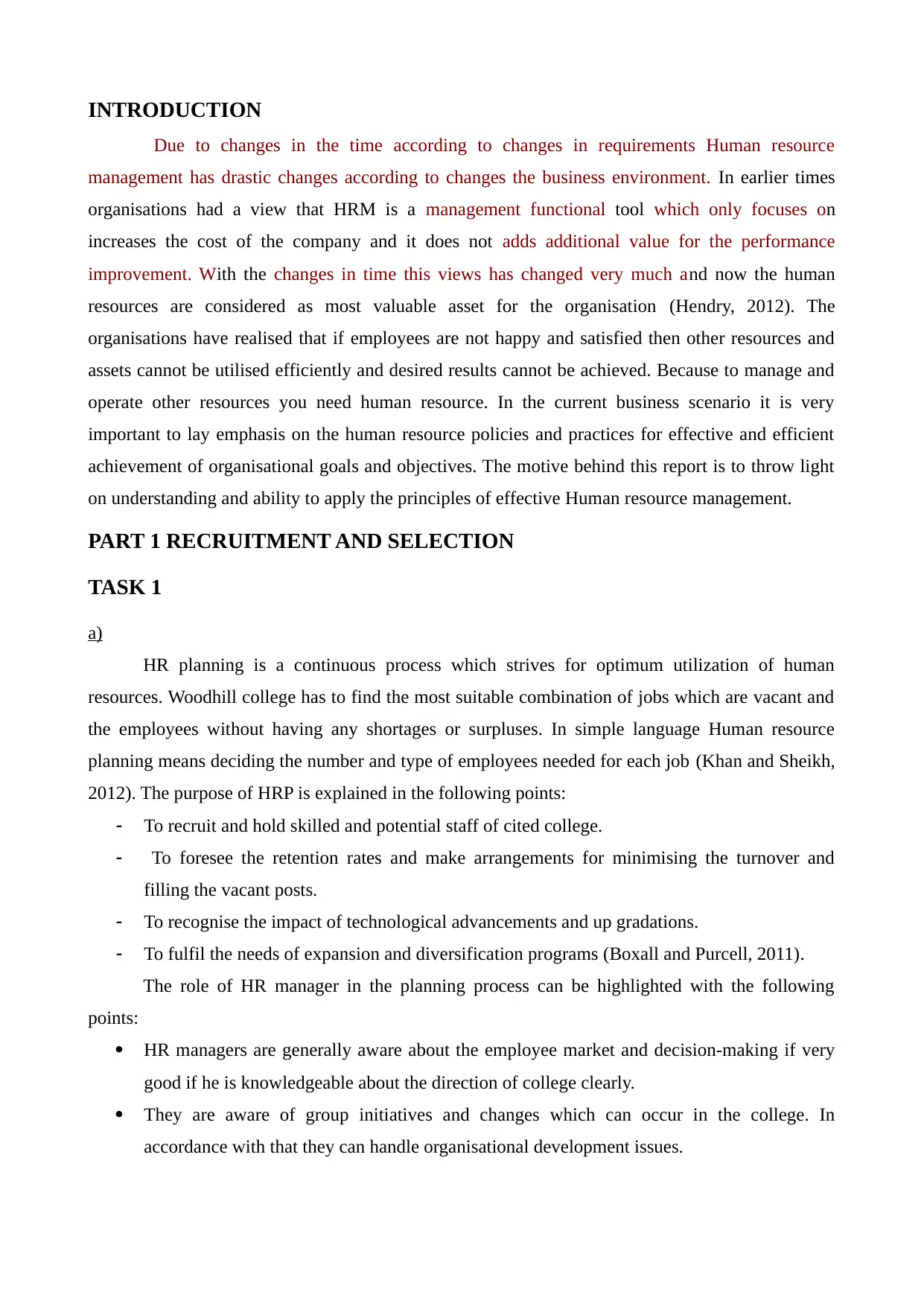
INTRODUCTION
Due to changes in the time according to changes in requirements Human resource
management has drastic changes according to changes the business environment. In earlier times
organisations had a view that HRM is a management functional tool which only focuses on
increases the cost of the company and it does not adds additional value for the performance
improvement. With the changes in time this views has changed very much and now the human
resources are considered as most valuable asset for the organisation (Hendry, 2012). The
organisations have realised that if employees are not happy and satisfied then other resources and
assets cannot be utilised efficiently and desired results cannot be achieved. Because to manage and
operate other resources you need human resource. In the current business scenario it is very
important to lay emphasis on the human resource policies and practices for effective and efficient
achievement of organisational goals and objectives. The motive behind this report is to throw light
on understanding and ability to apply the principles of effective Human resource management.
PART 1 RECRUITMENT AND SELECTION
TASK 1
a)
HR planning is a continuous process which strives for optimum utilization of human
resources. Woodhill college has to find the most suitable combination of jobs which are vacant and
the employees without having any shortages or surpluses. In simple language Human resource
planning means deciding the number and type of employees needed for each job (Khan and Sheikh,
2012). The purpose of HRP is explained in the following points:
To recruit and hold skilled and potential staff of cited college.
To foresee the retention rates and make arrangements for minimising the turnover and
filling the vacant posts.
To recognise the impact of technological advancements and up gradations.
To fulfil the needs of expansion and diversification programs (Boxall and Purcell, 2011).
The role of HR manager in the planning process can be highlighted with the following
points:
HR managers are generally aware about the employee market and decision-making if very
good if he is knowledgeable about the direction of college clearly.
They are aware of group initiatives and changes which can occur in the college. In
accordance with that they can handle organisational development issues.
Due to changes in the time according to changes in requirements Human resource
management has drastic changes according to changes the business environment. In earlier times
organisations had a view that HRM is a management functional tool which only focuses on
increases the cost of the company and it does not adds additional value for the performance
improvement. With the changes in time this views has changed very much and now the human
resources are considered as most valuable asset for the organisation (Hendry, 2012). The
organisations have realised that if employees are not happy and satisfied then other resources and
assets cannot be utilised efficiently and desired results cannot be achieved. Because to manage and
operate other resources you need human resource. In the current business scenario it is very
important to lay emphasis on the human resource policies and practices for effective and efficient
achievement of organisational goals and objectives. The motive behind this report is to throw light
on understanding and ability to apply the principles of effective Human resource management.
PART 1 RECRUITMENT AND SELECTION
TASK 1
a)
HR planning is a continuous process which strives for optimum utilization of human
resources. Woodhill college has to find the most suitable combination of jobs which are vacant and
the employees without having any shortages or surpluses. In simple language Human resource
planning means deciding the number and type of employees needed for each job (Khan and Sheikh,
2012). The purpose of HRP is explained in the following points:
To recruit and hold skilled and potential staff of cited college.
To foresee the retention rates and make arrangements for minimising the turnover and
filling the vacant posts.
To recognise the impact of technological advancements and up gradations.
To fulfil the needs of expansion and diversification programs (Boxall and Purcell, 2011).
The role of HR manager in the planning process can be highlighted with the following
points:
HR managers are generally aware about the employee market and decision-making if very
good if he is knowledgeable about the direction of college clearly.
They are aware of group initiatives and changes which can occur in the college. In
accordance with that they can handle organisational development issues.
⊘ This is a preview!⊘
Do you want full access?
Subscribe today to unlock all pages.

Trusted by 1+ million students worldwide
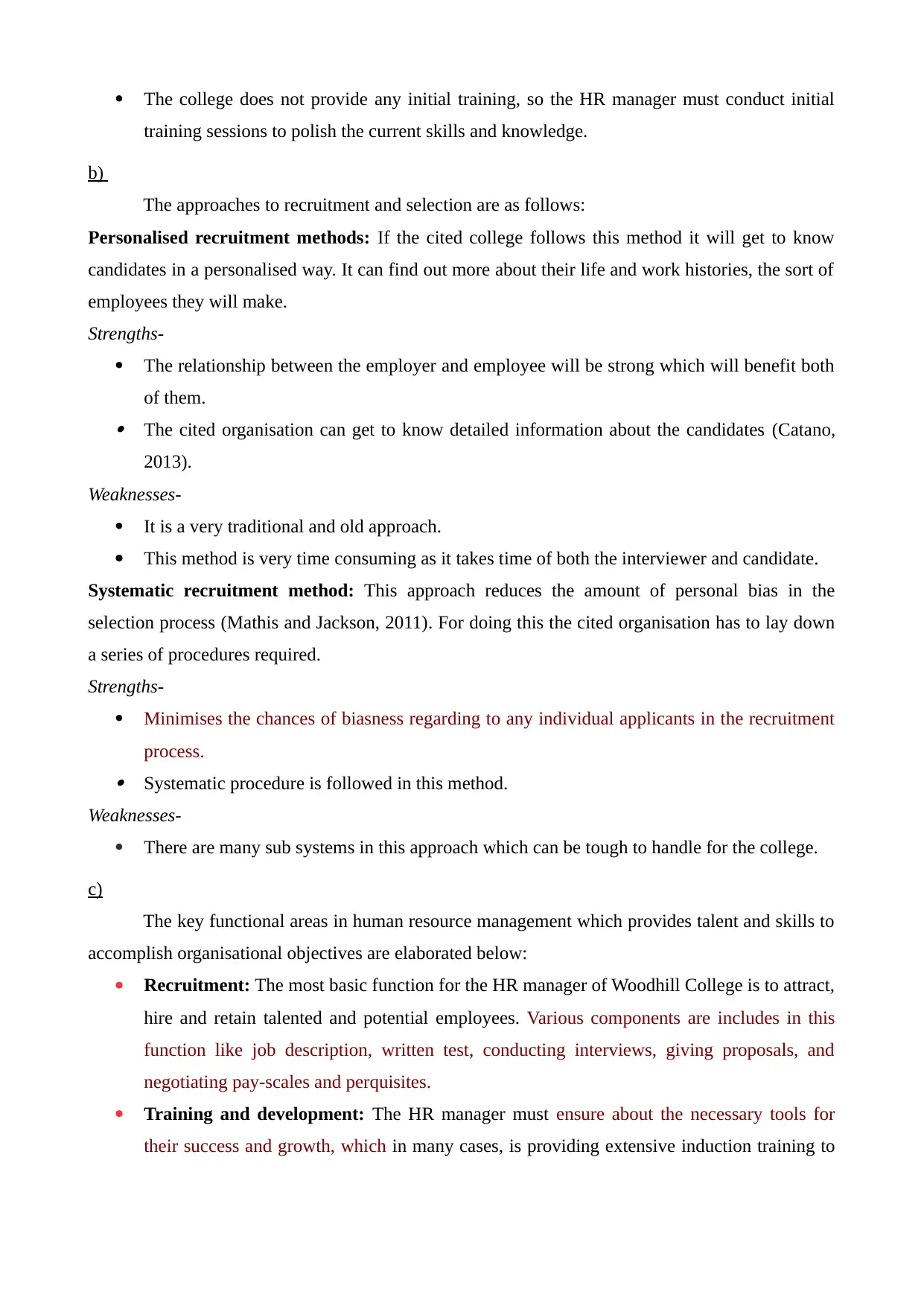
The college does not provide any initial training, so the HR manager must conduct initial
training sessions to polish the current skills and knowledge.
b)
The approaches to recruitment and selection are as follows:
Personalised recruitment methods: If the cited college follows this method it will get to know
candidates in a personalised way. It can find out more about their life and work histories, the sort of
employees they will make.
Strengths-
The relationship between the employer and employee will be strong which will benefit both
of them. The cited organisation can get to know detailed information about the candidates (Catano,
2013).
Weaknesses-
It is a very traditional and old approach.
This method is very time consuming as it takes time of both the interviewer and candidate.
Systematic recruitment method: This approach reduces the amount of personal bias in the
selection process (Mathis and Jackson, 2011). For doing this the cited organisation has to lay down
a series of procedures required.
Strengths-
Minimises the chances of biasness regarding to any individual applicants in the recruitment
process. Systematic procedure is followed in this method.
Weaknesses-
There are many sub systems in this approach which can be tough to handle for the college.
c)
The key functional areas in human resource management which provides talent and skills to
accomplish organisational objectives are elaborated below:
Recruitment: The most basic function for the HR manager of Woodhill College is to attract,
hire and retain talented and potential employees. Various components are includes in this
function like job description, written test, conducting interviews, giving proposals, and
negotiating pay-scales and perquisites.
Training and development: The HR manager must ensure about the necessary tools for
their success and growth, which in many cases, is providing extensive induction training to
training sessions to polish the current skills and knowledge.
b)
The approaches to recruitment and selection are as follows:
Personalised recruitment methods: If the cited college follows this method it will get to know
candidates in a personalised way. It can find out more about their life and work histories, the sort of
employees they will make.
Strengths-
The relationship between the employer and employee will be strong which will benefit both
of them. The cited organisation can get to know detailed information about the candidates (Catano,
2013).
Weaknesses-
It is a very traditional and old approach.
This method is very time consuming as it takes time of both the interviewer and candidate.
Systematic recruitment method: This approach reduces the amount of personal bias in the
selection process (Mathis and Jackson, 2011). For doing this the cited organisation has to lay down
a series of procedures required.
Strengths-
Minimises the chances of biasness regarding to any individual applicants in the recruitment
process. Systematic procedure is followed in this method.
Weaknesses-
There are many sub systems in this approach which can be tough to handle for the college.
c)
The key functional areas in human resource management which provides talent and skills to
accomplish organisational objectives are elaborated below:
Recruitment: The most basic function for the HR manager of Woodhill College is to attract,
hire and retain talented and potential employees. Various components are includes in this
function like job description, written test, conducting interviews, giving proposals, and
negotiating pay-scales and perquisites.
Training and development: The HR manager must ensure about the necessary tools for
their success and growth, which in many cases, is providing extensive induction training to
Paraphrase This Document
Need a fresh take? Get an instant paraphrase of this document with our AI Paraphraser
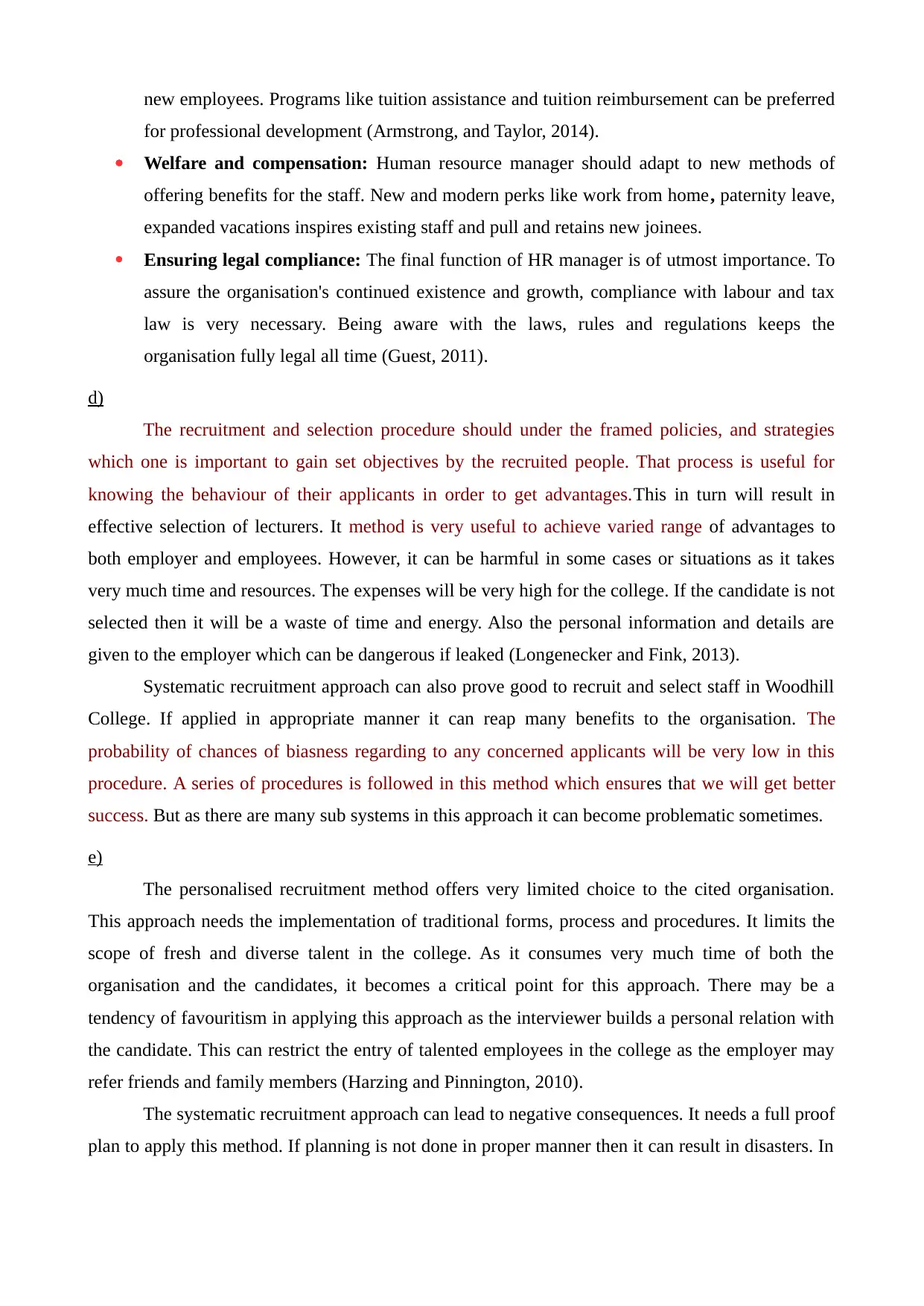
new employees. Programs like tuition assistance and tuition reimbursement can be preferred
for professional development (Armstrong, and Taylor, 2014).
Welfare and compensation: Human resource manager should adapt to new methods of
offering benefits for the staff. New and modern perks like work from home, paternity leave,
expanded vacations inspires existing staff and pull and retains new joinees.
Ensuring legal compliance: The final function of HR manager is of utmost importance. To
assure the organisation's continued existence and growth, compliance with labour and tax
law is very necessary. Being aware with the laws, rules and regulations keeps the
organisation fully legal all time (Guest, 2011).
d)
The recruitment and selection procedure should under the framed policies, and strategies
which one is important to gain set objectives by the recruited people. That process is useful for
knowing the behaviour of their applicants in order to get advantages.This in turn will result in
effective selection of lecturers. It method is very useful to achieve varied range of advantages to
both employer and employees. However, it can be harmful in some cases or situations as it takes
very much time and resources. The expenses will be very high for the college. If the candidate is not
selected then it will be a waste of time and energy. Also the personal information and details are
given to the employer which can be dangerous if leaked (Longenecker and Fink, 2013).
Systematic recruitment approach can also prove good to recruit and select staff in Woodhill
College. If applied in appropriate manner it can reap many benefits to the organisation. The
probability of chances of biasness regarding to any concerned applicants will be very low in this
procedure. A series of procedures is followed in this method which ensures that we will get better
success. But as there are many sub systems in this approach it can become problematic sometimes.
e)
The personalised recruitment method offers very limited choice to the cited organisation.
This approach needs the implementation of traditional forms, process and procedures. It limits the
scope of fresh and diverse talent in the college. As it consumes very much time of both the
organisation and the candidates, it becomes a critical point for this approach. There may be a
tendency of favouritism in applying this approach as the interviewer builds a personal relation with
the candidate. This can restrict the entry of talented employees in the college as the employer may
refer friends and family members (Harzing and Pinnington, 2010).
The systematic recruitment approach can lead to negative consequences. It needs a full proof
plan to apply this method. If planning is not done in proper manner then it can result in disasters. In
for professional development (Armstrong, and Taylor, 2014).
Welfare and compensation: Human resource manager should adapt to new methods of
offering benefits for the staff. New and modern perks like work from home, paternity leave,
expanded vacations inspires existing staff and pull and retains new joinees.
Ensuring legal compliance: The final function of HR manager is of utmost importance. To
assure the organisation's continued existence and growth, compliance with labour and tax
law is very necessary. Being aware with the laws, rules and regulations keeps the
organisation fully legal all time (Guest, 2011).
d)
The recruitment and selection procedure should under the framed policies, and strategies
which one is important to gain set objectives by the recruited people. That process is useful for
knowing the behaviour of their applicants in order to get advantages.This in turn will result in
effective selection of lecturers. It method is very useful to achieve varied range of advantages to
both employer and employees. However, it can be harmful in some cases or situations as it takes
very much time and resources. The expenses will be very high for the college. If the candidate is not
selected then it will be a waste of time and energy. Also the personal information and details are
given to the employer which can be dangerous if leaked (Longenecker and Fink, 2013).
Systematic recruitment approach can also prove good to recruit and select staff in Woodhill
College. If applied in appropriate manner it can reap many benefits to the organisation. The
probability of chances of biasness regarding to any concerned applicants will be very low in this
procedure. A series of procedures is followed in this method which ensures that we will get better
success. But as there are many sub systems in this approach it can become problematic sometimes.
e)
The personalised recruitment method offers very limited choice to the cited organisation.
This approach needs the implementation of traditional forms, process and procedures. It limits the
scope of fresh and diverse talent in the college. As it consumes very much time of both the
organisation and the candidates, it becomes a critical point for this approach. There may be a
tendency of favouritism in applying this approach as the interviewer builds a personal relation with
the candidate. This can restrict the entry of talented employees in the college as the employer may
refer friends and family members (Harzing and Pinnington, 2010).
The systematic recruitment approach can lead to negative consequences. It needs a full proof
plan to apply this method. If planning is not done in proper manner then it can result in disasters. In
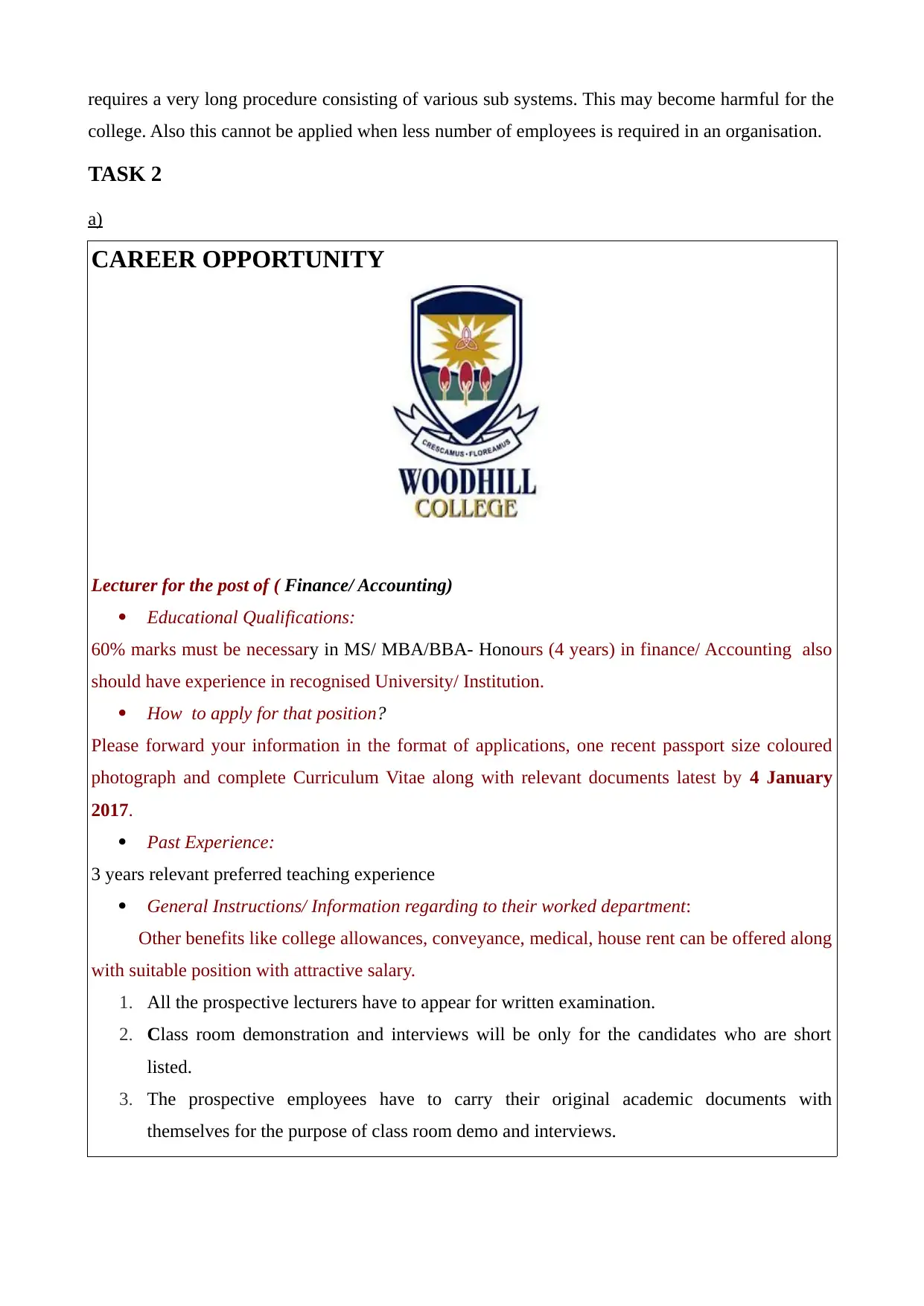
requires a very long procedure consisting of various sub systems. This may become harmful for the
college. Also this cannot be applied when less number of employees is required in an organisation.
TASK 2
a)
CAREER OPPORTUNITY
Lecturer for the post of ( Finance/ Accounting)
Educational Qualifications:
60% marks must be necessary in MS/ MBA/BBA- Honours (4 years) in finance/ Accounting also
should have experience in recognised University/ Institution.
How to apply for that position?
Please forward your information in the format of applications, one recent passport size coloured
photograph and complete Curriculum Vitae along with relevant documents latest by 4 January
2017.
Past Experience:
3 years relevant preferred teaching experience
General Instructions/ Information regarding to their worked department:
Other benefits like college allowances, conveyance, medical, house rent can be offered along
with suitable position with attractive salary.
1. All the prospective lecturers have to appear for written examination.
2. Class room demonstration and interviews will be only for the candidates who are short
listed.
3. The prospective employees have to carry their original academic documents with
themselves for the purpose of class room demo and interviews.
college. Also this cannot be applied when less number of employees is required in an organisation.
TASK 2
a)
CAREER OPPORTUNITY
Lecturer for the post of ( Finance/ Accounting)
Educational Qualifications:
60% marks must be necessary in MS/ MBA/BBA- Honours (4 years) in finance/ Accounting also
should have experience in recognised University/ Institution.
How to apply for that position?
Please forward your information in the format of applications, one recent passport size coloured
photograph and complete Curriculum Vitae along with relevant documents latest by 4 January
2017.
Past Experience:
3 years relevant preferred teaching experience
General Instructions/ Information regarding to their worked department:
Other benefits like college allowances, conveyance, medical, house rent can be offered along
with suitable position with attractive salary.
1. All the prospective lecturers have to appear for written examination.
2. Class room demonstration and interviews will be only for the candidates who are short
listed.
3. The prospective employees have to carry their original academic documents with
themselves for the purpose of class room demo and interviews.
⊘ This is a preview!⊘
Do you want full access?
Subscribe today to unlock all pages.

Trusted by 1+ million students worldwide
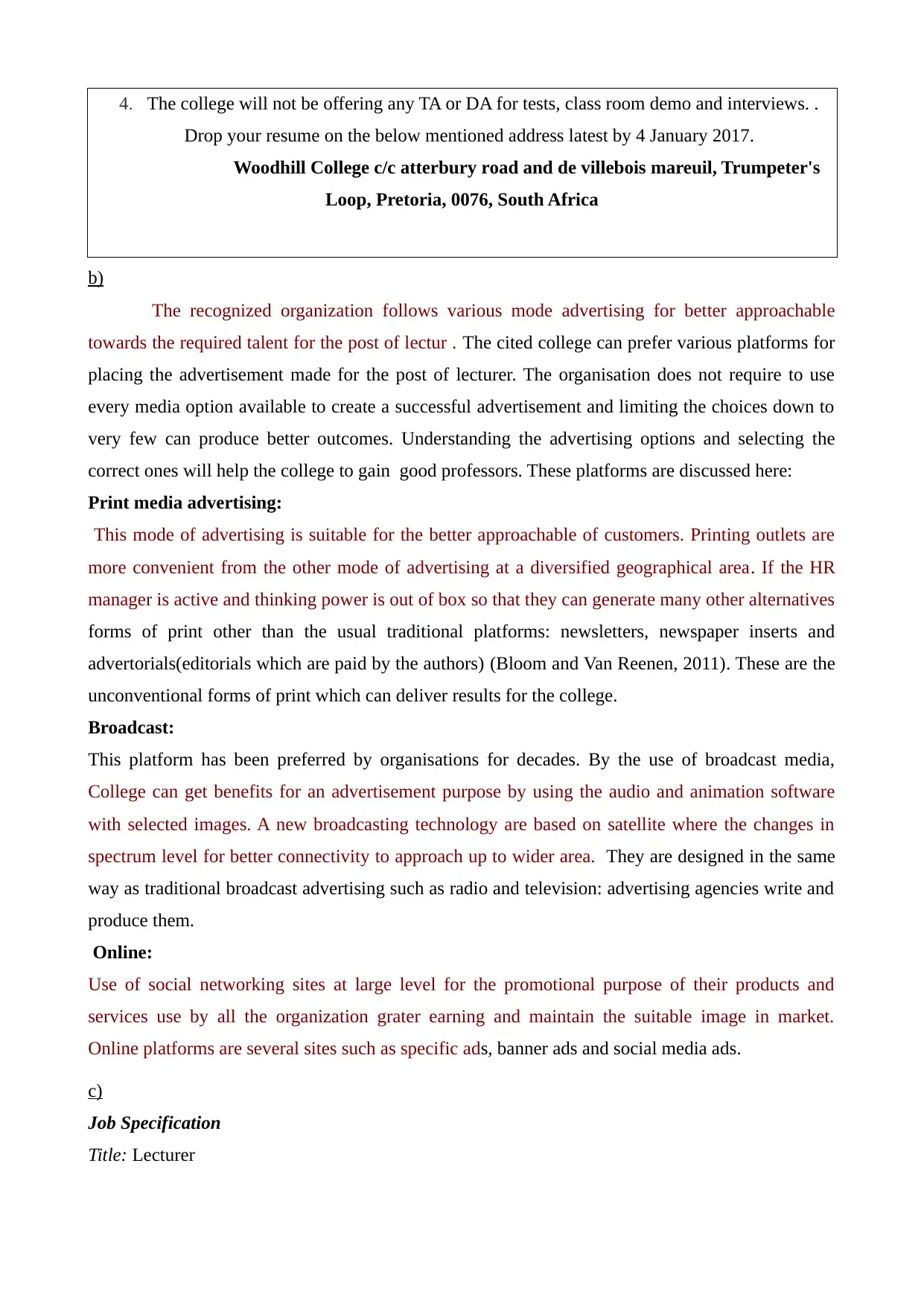
4. The college will not be offering any TA or DA for tests, class room demo and interviews. .
Drop your resume on the below mentioned address latest by 4 January 2017.
Woodhill College c/c atterbury road and de villebois mareuil, Trumpeter's
Loop, Pretoria, 0076, South Africa
b)
The recognized organization follows various mode advertising for better approachable
towards the required talent for the post of lectur . The cited college can prefer various platforms for
placing the advertisement made for the post of lecturer. The organisation does not require to use
every media option available to create a successful advertisement and limiting the choices down to
very few can produce better outcomes. Understanding the advertising options and selecting the
correct ones will help the college to gain good professors. These platforms are discussed here:
Print media advertising:
This mode of advertising is suitable for the better approachable of customers. Printing outlets are
more convenient from the other mode of advertising at a diversified geographical area. If the HR
manager is active and thinking power is out of box so that they can generate many other alternatives
forms of print other than the usual traditional platforms: newsletters, newspaper inserts and
advertorials(editorials which are paid by the authors) (Bloom and Van Reenen, 2011). These are the
unconventional forms of print which can deliver results for the college.
Broadcast:
This platform has been preferred by organisations for decades. By the use of broadcast media,
College can get benefits for an advertisement purpose by using the audio and animation software
with selected images. A new broadcasting technology are based on satellite where the changes in
spectrum level for better connectivity to approach up to wider area. They are designed in the same
way as traditional broadcast advertising such as radio and television: advertising agencies write and
produce them.
Online:
Use of social networking sites at large level for the promotional purpose of their products and
services use by all the organization grater earning and maintain the suitable image in market.
Online platforms are several sites such as specific ads, banner ads and social media ads.
c)
Job Specification
Title: Lecturer
Drop your resume on the below mentioned address latest by 4 January 2017.
Woodhill College c/c atterbury road and de villebois mareuil, Trumpeter's
Loop, Pretoria, 0076, South Africa
b)
The recognized organization follows various mode advertising for better approachable
towards the required talent for the post of lectur . The cited college can prefer various platforms for
placing the advertisement made for the post of lecturer. The organisation does not require to use
every media option available to create a successful advertisement and limiting the choices down to
very few can produce better outcomes. Understanding the advertising options and selecting the
correct ones will help the college to gain good professors. These platforms are discussed here:
Print media advertising:
This mode of advertising is suitable for the better approachable of customers. Printing outlets are
more convenient from the other mode of advertising at a diversified geographical area. If the HR
manager is active and thinking power is out of box so that they can generate many other alternatives
forms of print other than the usual traditional platforms: newsletters, newspaper inserts and
advertorials(editorials which are paid by the authors) (Bloom and Van Reenen, 2011). These are the
unconventional forms of print which can deliver results for the college.
Broadcast:
This platform has been preferred by organisations for decades. By the use of broadcast media,
College can get benefits for an advertisement purpose by using the audio and animation software
with selected images. A new broadcasting technology are based on satellite where the changes in
spectrum level for better connectivity to approach up to wider area. They are designed in the same
way as traditional broadcast advertising such as radio and television: advertising agencies write and
produce them.
Online:
Use of social networking sites at large level for the promotional purpose of their products and
services use by all the organization grater earning and maintain the suitable image in market.
Online platforms are several sites such as specific ads, banner ads and social media ads.
c)
Job Specification
Title: Lecturer
Paraphrase This Document
Need a fresh take? Get an instant paraphrase of this document with our AI Paraphraser
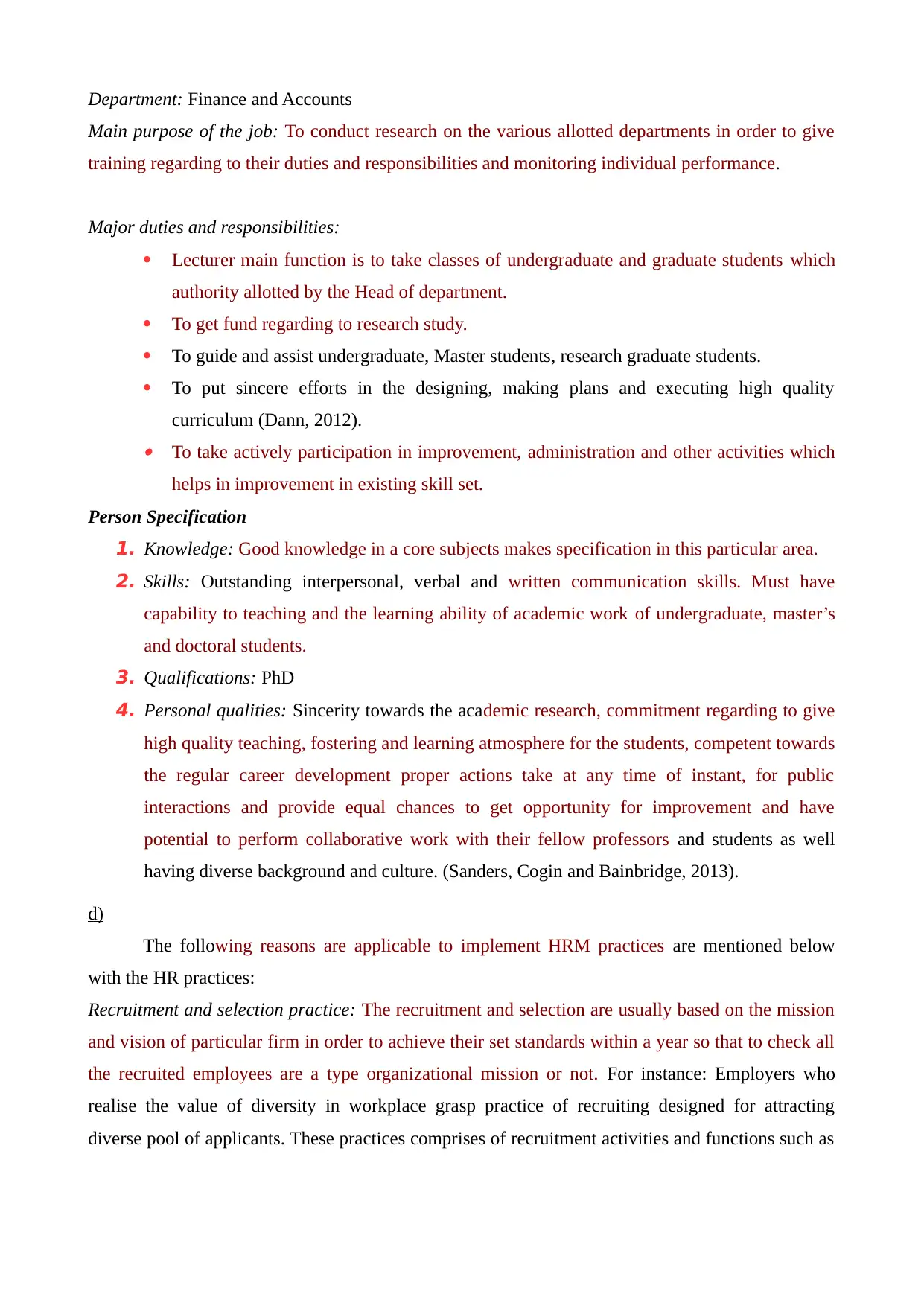
Department: Finance and Accounts
Main purpose of the job: To conduct research on the various allotted departments in order to give
training regarding to their duties and responsibilities and monitoring individual performance.
Major duties and responsibilities:
Lecturer main function is to take classes of undergraduate and graduate students which
authority allotted by the Head of department.
To get fund regarding to research study.
To guide and assist undergraduate, Master students, research graduate students.
To put sincere efforts in the designing, making plans and executing high quality
curriculum (Dann, 2012). To take actively participation in improvement, administration and other activities which
helps in improvement in existing skill set.
Person Specification
1. Knowledge: Good knowledge in a core subjects makes specification in this particular area.
2. Skills: Outstanding interpersonal, verbal and written communication skills. Must have
capability to teaching and the learning ability of academic work of undergraduate, master’s
and doctoral students.
3. Qualifications: PhD
4. Personal qualities: Sincerity towards the academic research, commitment regarding to give
high quality teaching, fostering and learning atmosphere for the students, competent towards
the regular career development proper actions take at any time of instant, for public
interactions and provide equal chances to get opportunity for improvement and have
potential to perform collaborative work with their fellow professors and students as well
having diverse background and culture. (Sanders, Cogin and Bainbridge, 2013).
d)
The following reasons are applicable to implement HRM practices are mentioned below
with the HR practices:
Recruitment and selection practice: The recruitment and selection are usually based on the mission
and vision of particular firm in order to achieve their set standards within a year so that to check all
the recruited employees are a type organizational mission or not. For instance: Employers who
realise the value of diversity in workplace grasp practice of recruiting designed for attracting
diverse pool of applicants. These practices comprises of recruitment activities and functions such as
Main purpose of the job: To conduct research on the various allotted departments in order to give
training regarding to their duties and responsibilities and monitoring individual performance.
Major duties and responsibilities:
Lecturer main function is to take classes of undergraduate and graduate students which
authority allotted by the Head of department.
To get fund regarding to research study.
To guide and assist undergraduate, Master students, research graduate students.
To put sincere efforts in the designing, making plans and executing high quality
curriculum (Dann, 2012). To take actively participation in improvement, administration and other activities which
helps in improvement in existing skill set.
Person Specification
1. Knowledge: Good knowledge in a core subjects makes specification in this particular area.
2. Skills: Outstanding interpersonal, verbal and written communication skills. Must have
capability to teaching and the learning ability of academic work of undergraduate, master’s
and doctoral students.
3. Qualifications: PhD
4. Personal qualities: Sincerity towards the academic research, commitment regarding to give
high quality teaching, fostering and learning atmosphere for the students, competent towards
the regular career development proper actions take at any time of instant, for public
interactions and provide equal chances to get opportunity for improvement and have
potential to perform collaborative work with their fellow professors and students as well
having diverse background and culture. (Sanders, Cogin and Bainbridge, 2013).
d)
The following reasons are applicable to implement HRM practices are mentioned below
with the HR practices:
Recruitment and selection practice: The recruitment and selection are usually based on the mission
and vision of particular firm in order to achieve their set standards within a year so that to check all
the recruited employees are a type organizational mission or not. For instance: Employers who
realise the value of diversity in workplace grasp practice of recruiting designed for attracting
diverse pool of applicants. These practices comprises of recruitment activities and functions such as
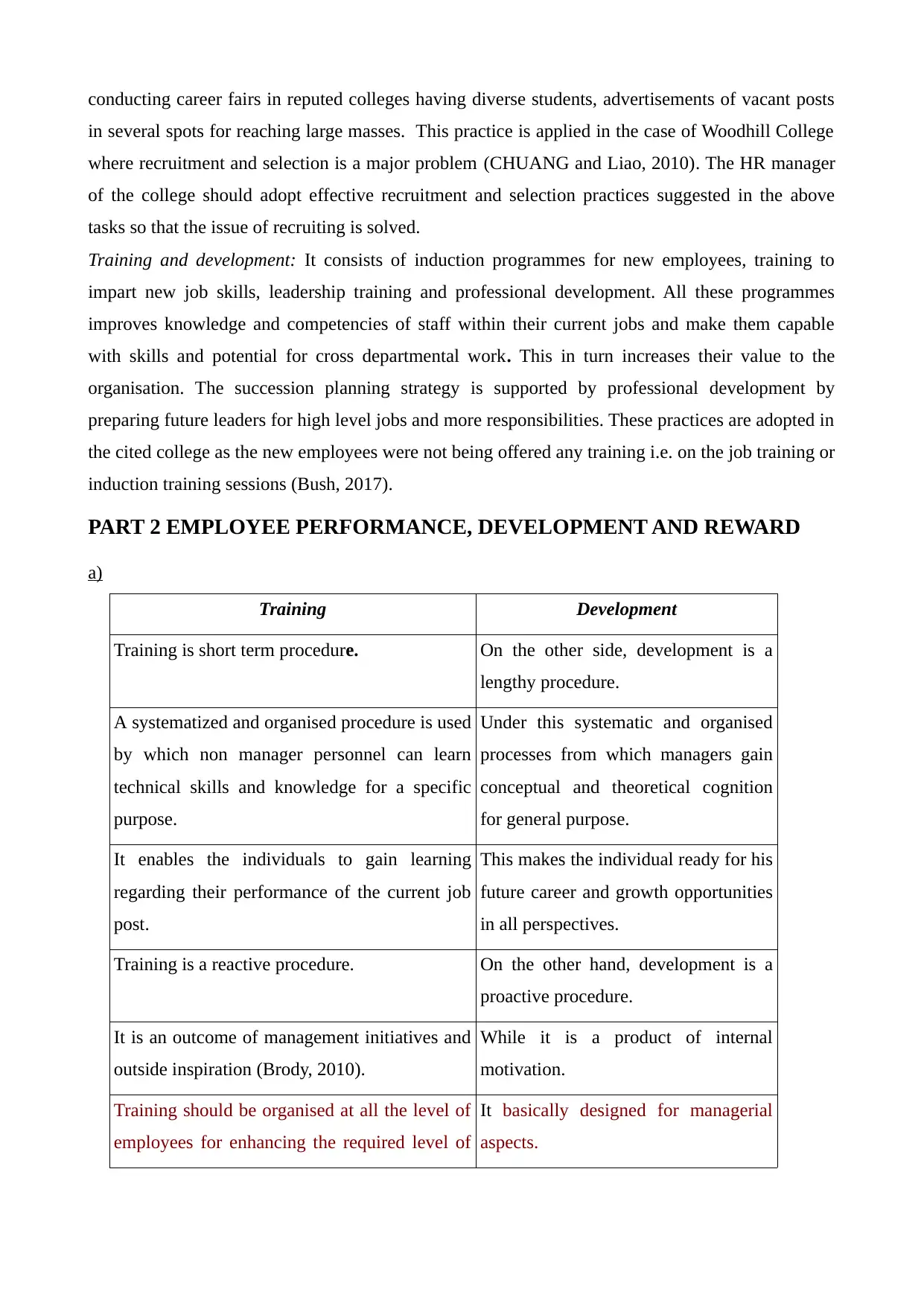
conducting career fairs in reputed colleges having diverse students, advertisements of vacant posts
in several spots for reaching large masses. This practice is applied in the case of Woodhill College
where recruitment and selection is a major problem (CHUANG and Liao, 2010). The HR manager
of the college should adopt effective recruitment and selection practices suggested in the above
tasks so that the issue of recruiting is solved.
Training and development: It consists of induction programmes for new employees, training to
impart new job skills, leadership training and professional development. All these programmes
improves knowledge and competencies of staff within their current jobs and make them capable
with skills and potential for cross departmental work. This in turn increases their value to the
organisation. The succession planning strategy is supported by professional development by
preparing future leaders for high level jobs and more responsibilities. These practices are adopted in
the cited college as the new employees were not being offered any training i.e. on the job training or
induction training sessions (Bush, 2017).
PART 2 EMPLOYEE PERFORMANCE, DEVELOPMENT AND REWARD
a)
Training Development
Training is short term procedure. On the other side, development is a
lengthy procedure.
A systematized and organised procedure is used
by which non manager personnel can learn
technical skills and knowledge for a specific
purpose.
Under this systematic and organised
processes from which managers gain
conceptual and theoretical cognition
for general purpose.
It enables the individuals to gain learning
regarding their performance of the current job
post.
This makes the individual ready for his
future career and growth opportunities
in all perspectives.
Training is a reactive procedure. On the other hand, development is a
proactive procedure.
It is an outcome of management initiatives and
outside inspiration (Brody, 2010).
While it is a product of internal
motivation.
Training should be organised at all the level of
employees for enhancing the required level of
It basically designed for managerial
aspects.
in several spots for reaching large masses. This practice is applied in the case of Woodhill College
where recruitment and selection is a major problem (CHUANG and Liao, 2010). The HR manager
of the college should adopt effective recruitment and selection practices suggested in the above
tasks so that the issue of recruiting is solved.
Training and development: It consists of induction programmes for new employees, training to
impart new job skills, leadership training and professional development. All these programmes
improves knowledge and competencies of staff within their current jobs and make them capable
with skills and potential for cross departmental work. This in turn increases their value to the
organisation. The succession planning strategy is supported by professional development by
preparing future leaders for high level jobs and more responsibilities. These practices are adopted in
the cited college as the new employees were not being offered any training i.e. on the job training or
induction training sessions (Bush, 2017).
PART 2 EMPLOYEE PERFORMANCE, DEVELOPMENT AND REWARD
a)
Training Development
Training is short term procedure. On the other side, development is a
lengthy procedure.
A systematized and organised procedure is used
by which non manager personnel can learn
technical skills and knowledge for a specific
purpose.
Under this systematic and organised
processes from which managers gain
conceptual and theoretical cognition
for general purpose.
It enables the individuals to gain learning
regarding their performance of the current job
post.
This makes the individual ready for his
future career and growth opportunities
in all perspectives.
Training is a reactive procedure. On the other hand, development is a
proactive procedure.
It is an outcome of management initiatives and
outside inspiration (Brody, 2010).
While it is a product of internal
motivation.
Training should be organised at all the level of
employees for enhancing the required level of
It basically designed for managerial
aspects.
⊘ This is a preview!⊘
Do you want full access?
Subscribe today to unlock all pages.

Trusted by 1+ million students worldwide
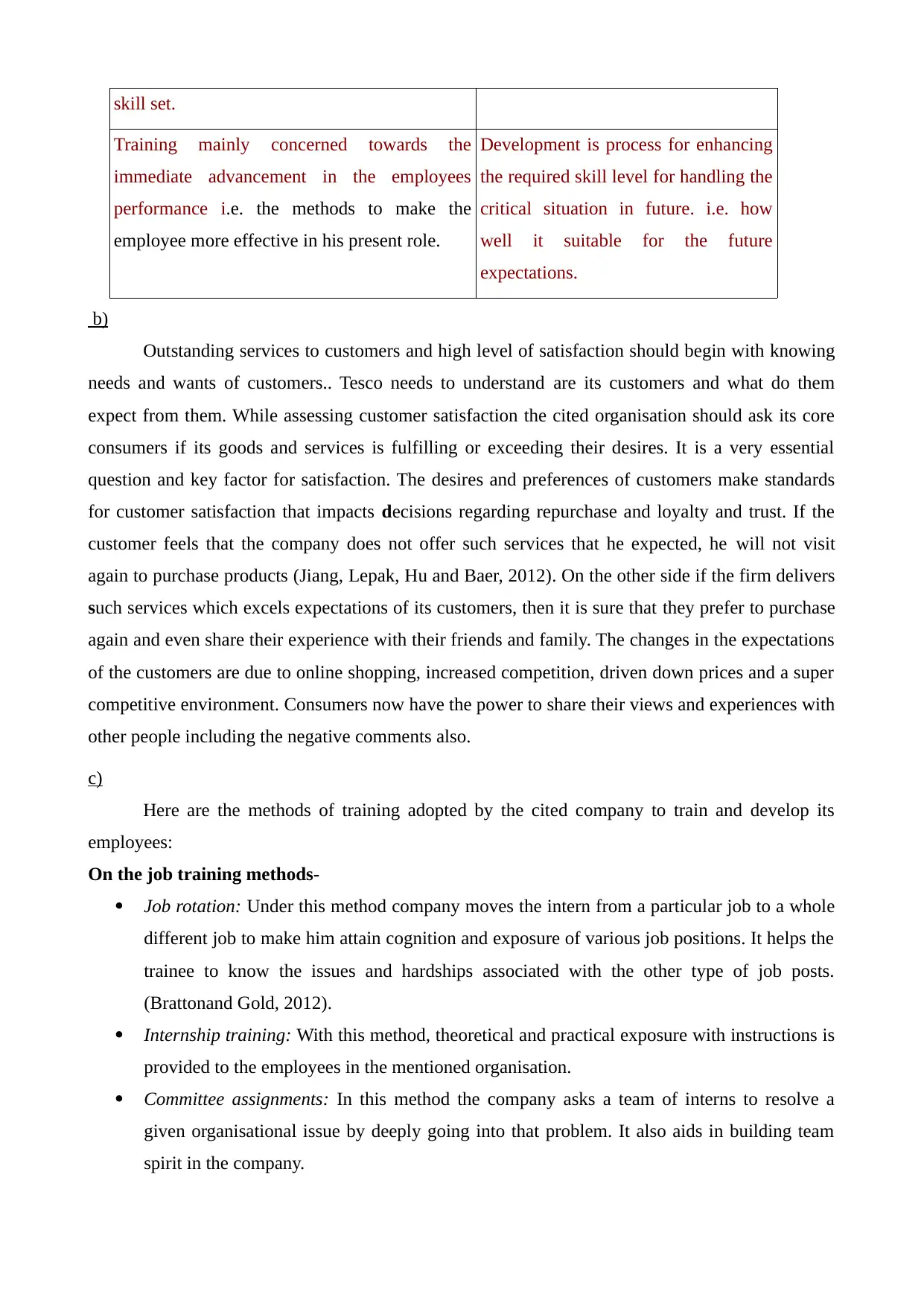
skill set.
Training mainly concerned towards the
immediate advancement in the employees
performance i.e. the methods to make the
employee more effective in his present role.
Development is process for enhancing
the required skill level for handling the
critical situation in future. i.e. how
well it suitable for the future
expectations.
b)
Outstanding services to customers and high level of satisfaction should begin with knowing
needs and wants of customers.. Tesco needs to understand are its customers and what do them
expect from them. While assessing customer satisfaction the cited organisation should ask its core
consumers if its goods and services is fulfilling or exceeding their desires. It is a very essential
question and key factor for satisfaction. The desires and preferences of customers make standards
for customer satisfaction that impacts decisions regarding repurchase and loyalty and trust. If the
customer feels that the company does not offer such services that he expected, he will not visit
again to purchase products (Jiang, Lepak, Hu and Baer, 2012). On the other side if the firm delivers
such services which excels expectations of its customers, then it is sure that they prefer to purchase
again and even share their experience with their friends and family. The changes in the expectations
of the customers are due to online shopping, increased competition, driven down prices and a super
competitive environment. Consumers now have the power to share their views and experiences with
other people including the negative comments also.
c)
Here are the methods of training adopted by the cited company to train and develop its
employees:
On the job training methods-
Job rotation: Under this method company moves the intern from a particular job to a whole
different job to make him attain cognition and exposure of various job positions. It helps the
trainee to know the issues and hardships associated with the other type of job posts.
(Brattonand Gold, 2012).
Internship training: With this method, theoretical and practical exposure with instructions is
provided to the employees in the mentioned organisation.
Committee assignments: In this method the company asks a team of interns to resolve a
given organisational issue by deeply going into that problem. It also aids in building team
spirit in the company.
Training mainly concerned towards the
immediate advancement in the employees
performance i.e. the methods to make the
employee more effective in his present role.
Development is process for enhancing
the required skill level for handling the
critical situation in future. i.e. how
well it suitable for the future
expectations.
b)
Outstanding services to customers and high level of satisfaction should begin with knowing
needs and wants of customers.. Tesco needs to understand are its customers and what do them
expect from them. While assessing customer satisfaction the cited organisation should ask its core
consumers if its goods and services is fulfilling or exceeding their desires. It is a very essential
question and key factor for satisfaction. The desires and preferences of customers make standards
for customer satisfaction that impacts decisions regarding repurchase and loyalty and trust. If the
customer feels that the company does not offer such services that he expected, he will not visit
again to purchase products (Jiang, Lepak, Hu and Baer, 2012). On the other side if the firm delivers
such services which excels expectations of its customers, then it is sure that they prefer to purchase
again and even share their experience with their friends and family. The changes in the expectations
of the customers are due to online shopping, increased competition, driven down prices and a super
competitive environment. Consumers now have the power to share their views and experiences with
other people including the negative comments also.
c)
Here are the methods of training adopted by the cited company to train and develop its
employees:
On the job training methods-
Job rotation: Under this method company moves the intern from a particular job to a whole
different job to make him attain cognition and exposure of various job positions. It helps the
trainee to know the issues and hardships associated with the other type of job posts.
(Brattonand Gold, 2012).
Internship training: With this method, theoretical and practical exposure with instructions is
provided to the employees in the mentioned organisation.
Committee assignments: In this method the company asks a team of interns to resolve a
given organisational issue by deeply going into that problem. It also aids in building team
spirit in the company.
Paraphrase This Document
Need a fresh take? Get an instant paraphrase of this document with our AI Paraphraser
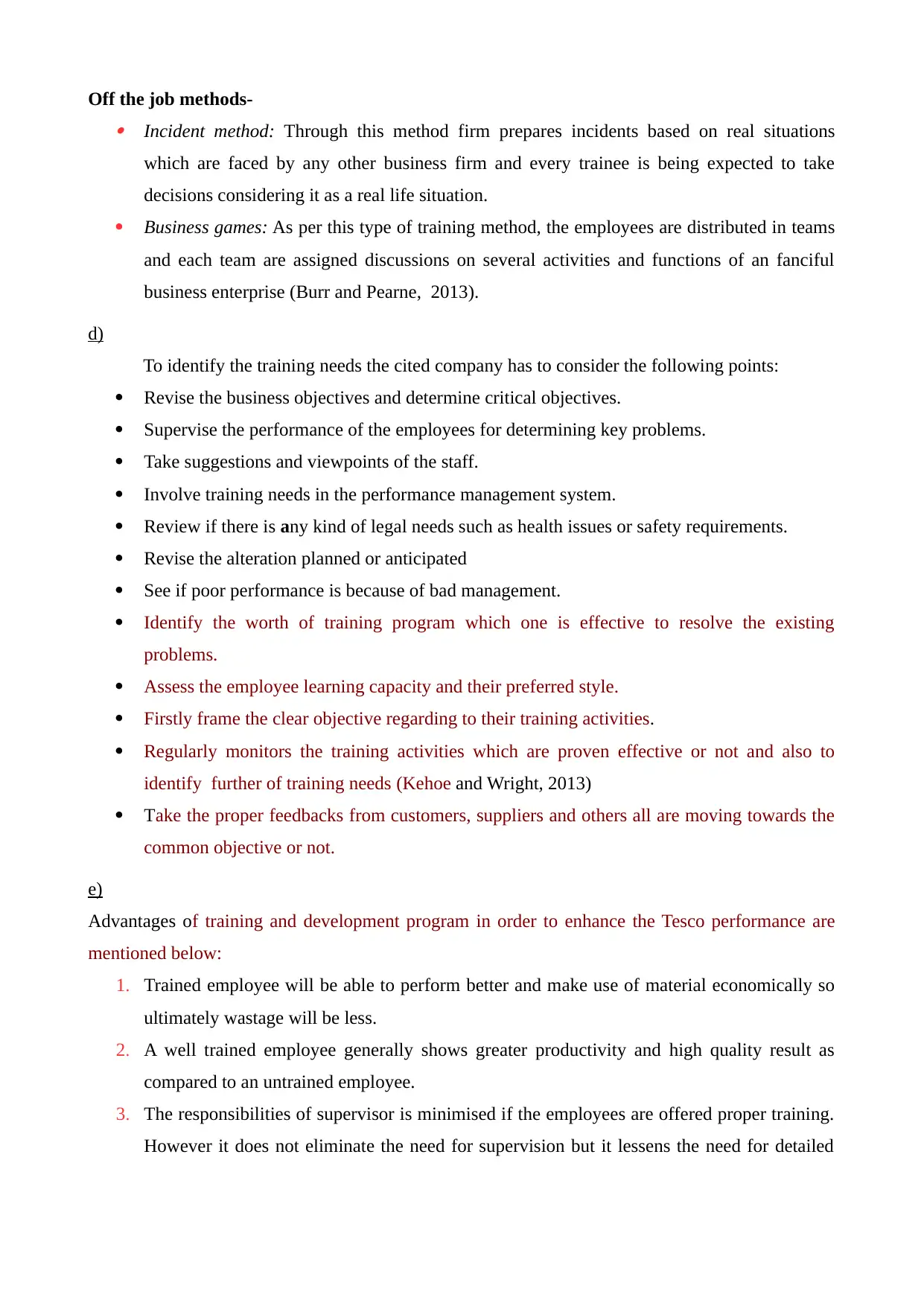
Off the job methods- Incident method: Through this method firm prepares incidents based on real situations
which are faced by any other business firm and every trainee is being expected to take
decisions considering it as a real life situation.
Business games: As per this type of training method, the employees are distributed in teams
and each team are assigned discussions on several activities and functions of an fanciful
business enterprise (Burr and Pearne, 2013).
d)
To identify the training needs the cited company has to consider the following points:
Revise the business objectives and determine critical objectives.
Supervise the performance of the employees for determining key problems.
Take suggestions and viewpoints of the staff.
Involve training needs in the performance management system.
Review if there is any kind of legal needs such as health issues or safety requirements.
Revise the alteration planned or anticipated
See if poor performance is because of bad management.
Identify the worth of training program which one is effective to resolve the existing
problems.
Assess the employee learning capacity and their preferred style.
Firstly frame the clear objective regarding to their training activities.
Regularly monitors the training activities which are proven effective or not and also to
identify further of training needs (Kehoe and Wright, 2013)
Take the proper feedbacks from customers, suppliers and others all are moving towards the
common objective or not.
e)
Advantages of training and development program in order to enhance the Tesco performance are
mentioned below:
1. Trained employee will be able to perform better and make use of material economically so
ultimately wastage will be less.
2. A well trained employee generally shows greater productivity and high quality result as
compared to an untrained employee.
3. The responsibilities of supervisor is minimised if the employees are offered proper training.
However it does not eliminate the need for supervision but it lessens the need for detailed
which are faced by any other business firm and every trainee is being expected to take
decisions considering it as a real life situation.
Business games: As per this type of training method, the employees are distributed in teams
and each team are assigned discussions on several activities and functions of an fanciful
business enterprise (Burr and Pearne, 2013).
d)
To identify the training needs the cited company has to consider the following points:
Revise the business objectives and determine critical objectives.
Supervise the performance of the employees for determining key problems.
Take suggestions and viewpoints of the staff.
Involve training needs in the performance management system.
Review if there is any kind of legal needs such as health issues or safety requirements.
Revise the alteration planned or anticipated
See if poor performance is because of bad management.
Identify the worth of training program which one is effective to resolve the existing
problems.
Assess the employee learning capacity and their preferred style.
Firstly frame the clear objective regarding to their training activities.
Regularly monitors the training activities which are proven effective or not and also to
identify further of training needs (Kehoe and Wright, 2013)
Take the proper feedbacks from customers, suppliers and others all are moving towards the
common objective or not.
e)
Advantages of training and development program in order to enhance the Tesco performance are
mentioned below:
1. Trained employee will be able to perform better and make use of material economically so
ultimately wastage will be less.
2. A well trained employee generally shows greater productivity and high quality result as
compared to an untrained employee.
3. The responsibilities of supervisor is minimised if the employees are offered proper training.
However it does not eliminate the need for supervision but it lessens the need for detailed
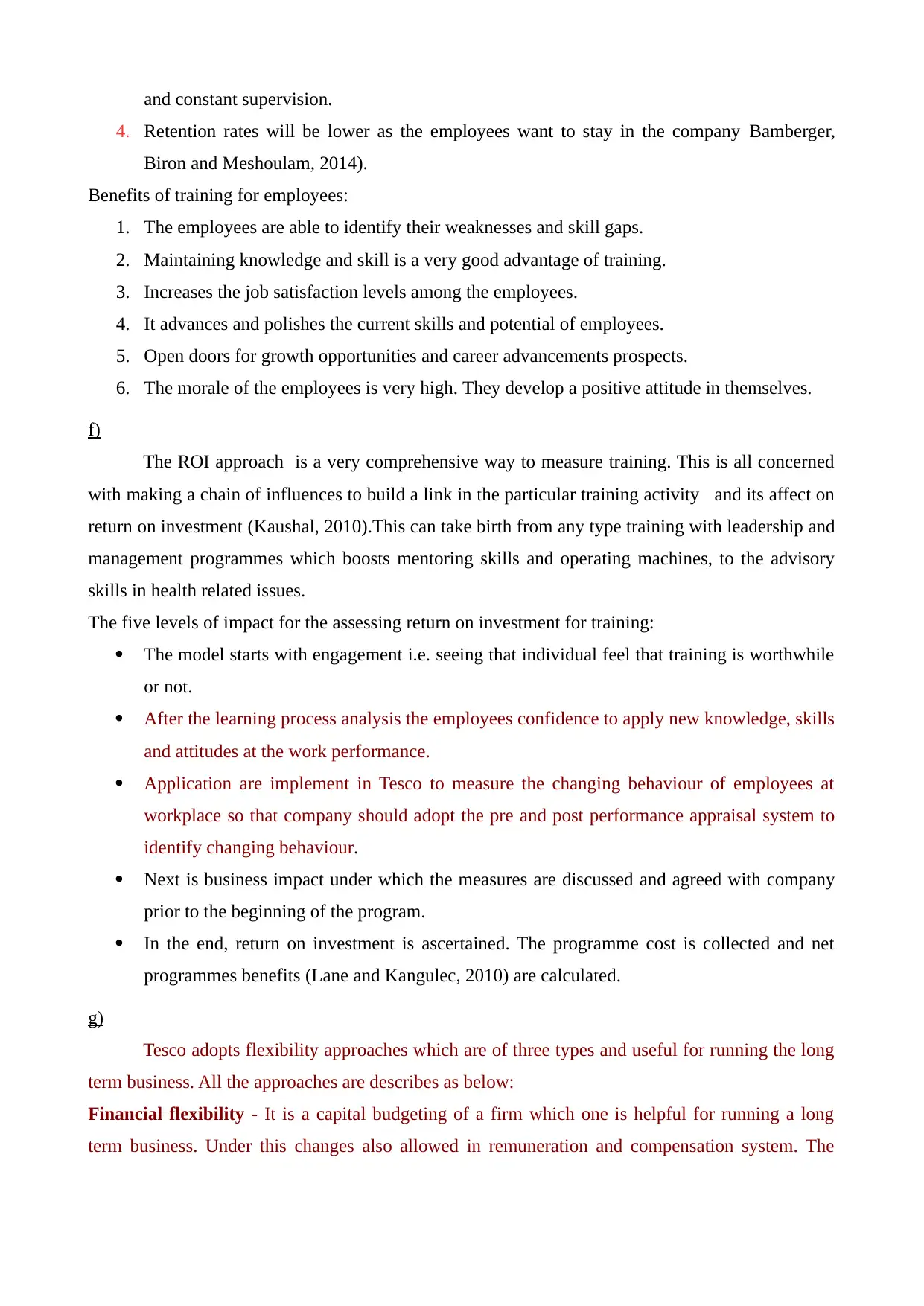
and constant supervision.
4. Retention rates will be lower as the employees want to stay in the company Bamberger,
Biron and Meshoulam, 2014).
Benefits of training for employees:
1. The employees are able to identify their weaknesses and skill gaps.
2. Maintaining knowledge and skill is a very good advantage of training.
3. Increases the job satisfaction levels among the employees.
4. It advances and polishes the current skills and potential of employees.
5. Open doors for growth opportunities and career advancements prospects.
6. The morale of the employees is very high. They develop a positive attitude in themselves.
f)
The ROI approach is a very comprehensive way to measure training. This is all concerned
with making a chain of influences to build a link in the particular training activity and its affect on
return on investment (Kaushal, 2010).This can take birth from any type training with leadership and
management programmes which boosts mentoring skills and operating machines, to the advisory
skills in health related issues.
The five levels of impact for the assessing return on investment for training:
The model starts with engagement i.e. seeing that individual feel that training is worthwhile
or not.
After the learning process analysis the employees confidence to apply new knowledge, skills
and attitudes at the work performance.
Application are implement in Tesco to measure the changing behaviour of employees at
workplace so that company should adopt the pre and post performance appraisal system to
identify changing behaviour.
Next is business impact under which the measures are discussed and agreed with company
prior to the beginning of the program.
In the end, return on investment is ascertained. The programme cost is collected and net
programmes benefits (Lane and Kangulec, 2010) are calculated.
g)
Tesco adopts flexibility approaches which are of three types and useful for running the long
term business. All the approaches are describes as below:
Financial flexibility - It is a capital budgeting of a firm which one is helpful for running a long
term business. Under this changes also allowed in remuneration and compensation system. The
4. Retention rates will be lower as the employees want to stay in the company Bamberger,
Biron and Meshoulam, 2014).
Benefits of training for employees:
1. The employees are able to identify their weaknesses and skill gaps.
2. Maintaining knowledge and skill is a very good advantage of training.
3. Increases the job satisfaction levels among the employees.
4. It advances and polishes the current skills and potential of employees.
5. Open doors for growth opportunities and career advancements prospects.
6. The morale of the employees is very high. They develop a positive attitude in themselves.
f)
The ROI approach is a very comprehensive way to measure training. This is all concerned
with making a chain of influences to build a link in the particular training activity and its affect on
return on investment (Kaushal, 2010).This can take birth from any type training with leadership and
management programmes which boosts mentoring skills and operating machines, to the advisory
skills in health related issues.
The five levels of impact for the assessing return on investment for training:
The model starts with engagement i.e. seeing that individual feel that training is worthwhile
or not.
After the learning process analysis the employees confidence to apply new knowledge, skills
and attitudes at the work performance.
Application are implement in Tesco to measure the changing behaviour of employees at
workplace so that company should adopt the pre and post performance appraisal system to
identify changing behaviour.
Next is business impact under which the measures are discussed and agreed with company
prior to the beginning of the program.
In the end, return on investment is ascertained. The programme cost is collected and net
programmes benefits (Lane and Kangulec, 2010) are calculated.
g)
Tesco adopts flexibility approaches which are of three types and useful for running the long
term business. All the approaches are describes as below:
Financial flexibility - It is a capital budgeting of a firm which one is helpful for running a long
term business. Under this changes also allowed in remuneration and compensation system. The
⊘ This is a preview!⊘
Do you want full access?
Subscribe today to unlock all pages.

Trusted by 1+ million students worldwide
1 out of 18
Related Documents
Your All-in-One AI-Powered Toolkit for Academic Success.
+13062052269
info@desklib.com
Available 24*7 on WhatsApp / Email
![[object Object]](/_next/static/media/star-bottom.7253800d.svg)
Unlock your academic potential
Copyright © 2020–2025 A2Z Services. All Rights Reserved. Developed and managed by ZUCOL.





